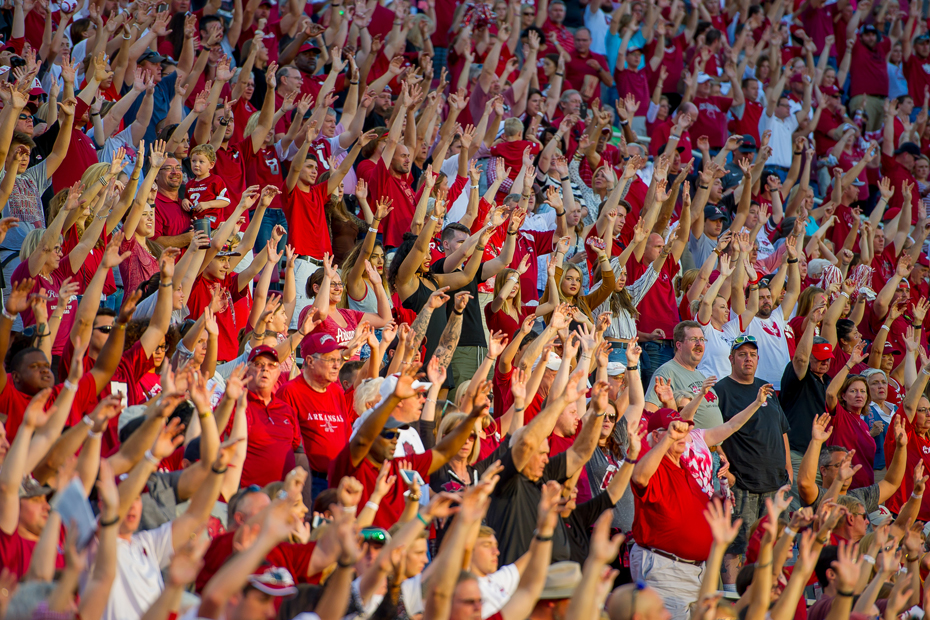
Saturday DWRRS Sound Goal: 120 dB
FAYETTEVILLE, Ark. – In 2012, Alabama quarterback Greg McElroy said to sports personality Paul Finebaum that Donald W. Reynolds Razorback Stadium was the loudest place he ever played. Four years later, is that statement still valid? Do the Razorbacks still hold a considerable home field advantage and will fans generate a similar, rowdy game day atmosphere on Saturday?
Based on how loud fans got against Louisiana Tech on Sept. 3 and against Texas State on Sept. 17, Razorback fans will have an ear-shattering surprise in store for the Crimson Tide.
This season, we’re measuring the amount of sound in decibels generated by fans at DWRRS without background music from the speakers or from the public announcer throughout four quarters of play. After two home games played at DWRRS, here’s what No. 1 Alabama, No. 14 Ole Miss, No. 18 Florida and LSU can expect to hear from Razorback fans when they visit the Hill:
On average throughout the course of a game, fans at DWRRS generate 91.3 dB of sound, peaking as high as 110.5 dB:
How loud is 91.3 dB? According to Hugh Churchill, an acoustics expert and assistant professor in the Department of Physics within the J. William Fulbright College of Arts and Sciences, 91.3 dB is equivalent to standing next to a running lawn mower. The U.S. Department of Health & Human Services also state that amount of sound is equivalent to a motorcycle passing by or riding inside a subway car.
The scatterplot graph above shows how loud fans got during each play against Louisiana Tech and Texas State. Sound generated by fans at DWRRS peaked into the 100-105 dB range several times during those games with the five loudest moments being:
1. 110.5 dB: Deatrich Wise Jr. and Jeremiah Ledbetter sacks Louisiana Tech QB J’Mar Smith on third down at its 48-yard line
Sound equivalent: Steel mill, car horn at 3 feet away, riveting machine
2. 110 dB: Arkansas Razorback defense steps on the field for the first time at home for the 2016 season against Louisiana Tech
Sound equivalent: Jackhammer, jet take-off from 1,000 feet away
3. 109.5 dB: Jeremy Sprinkle catches a four-yard touchdown pass from Austin Allen on fourth and goal at the Louisiana Tech four-yard line to give the Razorbacks a one-point lead, 21-20.
Sound equivalent: Outboard motor, power saw
4. 109.3 dB: Keon Hatcher’s 73-yard catch and run to the Texas State one-yard line that set up Kody Walker’s touchdown run.
Sound equivalent: Rock concert
5. 107.6 dB: Ryan Pulley’s pick-six in the second quarter against Texas State that lifted the Razorbacks to a 21-0 lead.
Churchill said when the crowd noise level at DWRRS peaks from about 90 to 100 dB, that represents an intensity increase of 10 times to have it sound twice as loud to the fans in attendance.
When the North End Zone addition and stadium-wide renovations are completed in 2018, one of the new features fans can look forward to will be a more enclosed DWRRS that traps additional crowd noise to help boost home field advantage on game days.
“The shape of a stadium does matter a lot,” Churchill said. “The way how stadiums can get really loud is when it keeps sound from escaping and makes it bounce around walls and the stands itself. The fact that [DWRRS] is currently more or less open along the North End Zone means that more sound can escape from that area than in a closed-in bowl stadium.”
Consider this – even with the look-in at the North End Zone, the 110.5 dB generated by 69,132 fans at the Louisiana Tech home opener came close to rivalling the loudest recorded decibel level at Tennessee’s Neyland Stadium. In 2015, 102,455 Volunteer fans only managed to reach 114 dB.
Not bad, Razorback fans.
#BeLoud this Saturday and break 120 dB.
